Road Runoff Harvesting and Infiltration Systems Literature Review
VerifiedAdded on 2023/06/03
|42
|12478
|87
Report
AI Summary
This report provides a comprehensive literature review on in-ground infiltration systems, focusing on their application in road runoff harvesting and reuse. It examines various stormwater modeling tools commonly used in Australia, including MUSIC, EPA SWMM, WaterCress, and others, detailing their functionalities and applicability in different stormwater management projects. The review explores the water quantity harvested, infiltration rates, and the issue of clogging in infiltration systems. Additionally, it investigates road runoff water quality, the use of different filter media for treatment, and the life cycle assessment of infiltration systems. The research highlights the use of street tree inlets by local councils in South Australia for harvesting polluted road runoff, emphasizing the need for scientific evidence on their performance in the Australian context. The report also covers the barriers in adoption of these systems, including planning, policy, knowledge, technical, and construction cost barriers, along with the environmental impacts of infiltration systems.
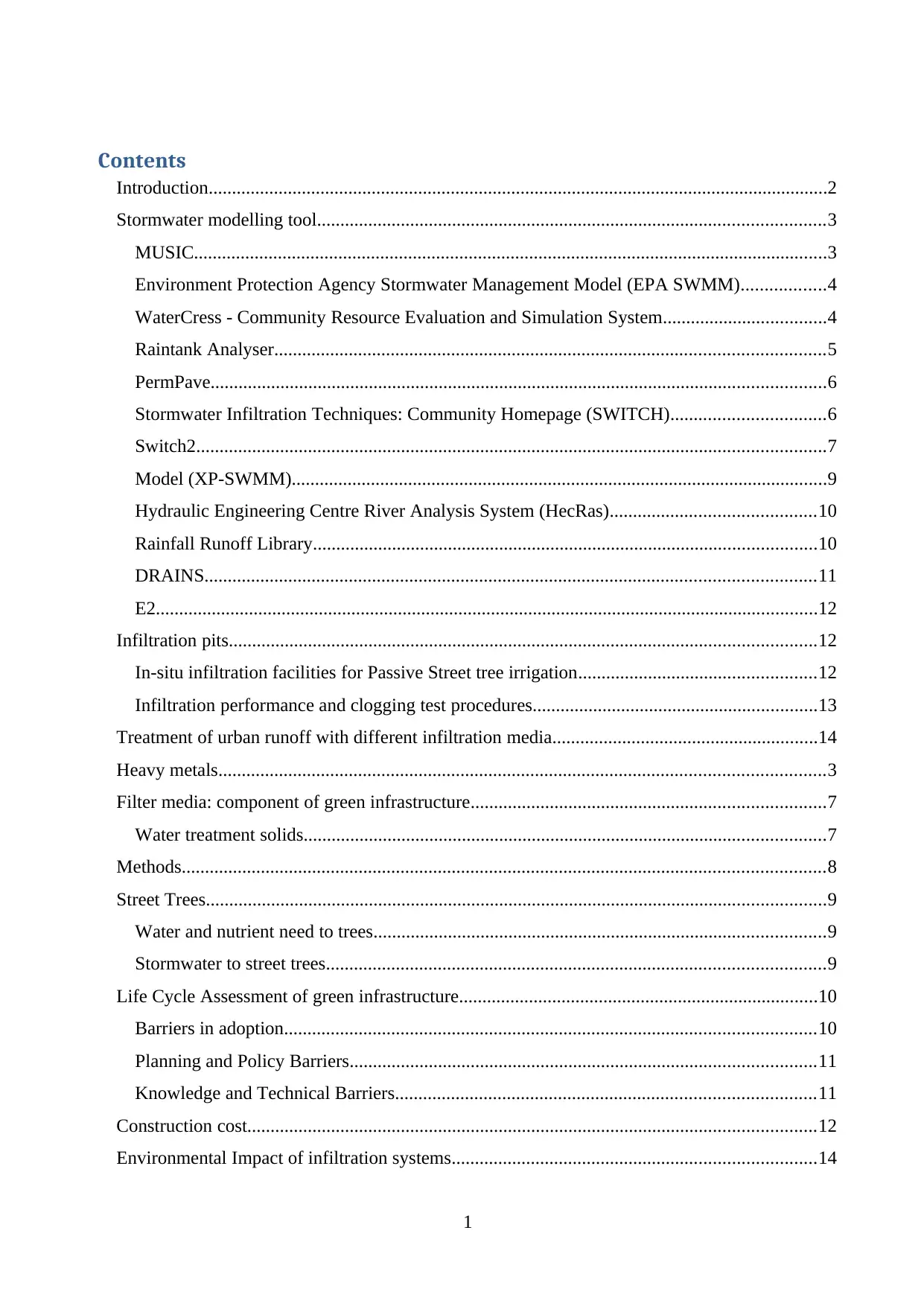
Contents
Introduction.....................................................................................................................................2
Stormwater modelling tool.............................................................................................................3
MUSIC........................................................................................................................................3
Environment Protection Agency Stormwater Management Model (EPA SWMM)..................4
WaterCress - Community Resource Evaluation and Simulation System...................................4
Raintank Analyser......................................................................................................................5
PermPave....................................................................................................................................6
Stormwater Infiltration Techniques: Community Homepage (SWITCH).................................6
Switch2.......................................................................................................................................7
Model (XP-SWMM)...................................................................................................................9
Hydraulic Engineering Centre River Analysis System (HecRas)............................................10
Rainfall Runoff Library............................................................................................................10
DRAINS...................................................................................................................................11
E2..............................................................................................................................................12
Infiltration pits..............................................................................................................................12
In-situ infiltration facilities for Passive Street tree irrigation...................................................12
Infiltration performance and clogging test procedures.............................................................13
Treatment of urban runoff with different infiltration media.........................................................14
Heavy metals..................................................................................................................................3
Filter media: component of green infrastructure............................................................................7
Water treatment solids................................................................................................................7
Methods..........................................................................................................................................8
Street Trees.....................................................................................................................................9
Water and nutrient need to trees.................................................................................................9
Stormwater to street trees...........................................................................................................9
Life Cycle Assessment of green infrastructure.............................................................................10
Barriers in adoption..................................................................................................................10
Planning and Policy Barriers....................................................................................................11
Knowledge and Technical Barriers..........................................................................................11
Construction cost..........................................................................................................................12
Environmental Impact of infiltration systems..............................................................................14
1
Introduction.....................................................................................................................................2
Stormwater modelling tool.............................................................................................................3
MUSIC........................................................................................................................................3
Environment Protection Agency Stormwater Management Model (EPA SWMM)..................4
WaterCress - Community Resource Evaluation and Simulation System...................................4
Raintank Analyser......................................................................................................................5
PermPave....................................................................................................................................6
Stormwater Infiltration Techniques: Community Homepage (SWITCH).................................6
Switch2.......................................................................................................................................7
Model (XP-SWMM)...................................................................................................................9
Hydraulic Engineering Centre River Analysis System (HecRas)............................................10
Rainfall Runoff Library............................................................................................................10
DRAINS...................................................................................................................................11
E2..............................................................................................................................................12
Infiltration pits..............................................................................................................................12
In-situ infiltration facilities for Passive Street tree irrigation...................................................12
Infiltration performance and clogging test procedures.............................................................13
Treatment of urban runoff with different infiltration media.........................................................14
Heavy metals..................................................................................................................................3
Filter media: component of green infrastructure............................................................................7
Water treatment solids................................................................................................................7
Methods..........................................................................................................................................8
Street Trees.....................................................................................................................................9
Water and nutrient need to trees.................................................................................................9
Stormwater to street trees...........................................................................................................9
Life Cycle Assessment of green infrastructure.............................................................................10
Barriers in adoption..................................................................................................................10
Planning and Policy Barriers....................................................................................................11
Knowledge and Technical Barriers..........................................................................................11
Construction cost..........................................................................................................................12
Environmental Impact of infiltration systems..............................................................................14
1
Paraphrase This Document
Need a fresh take? Get an instant paraphrase of this document with our AI Paraphraser

Summary of literature...................................................................................................................18
References........................................................................................................................................19
2
References........................................................................................................................................19
2
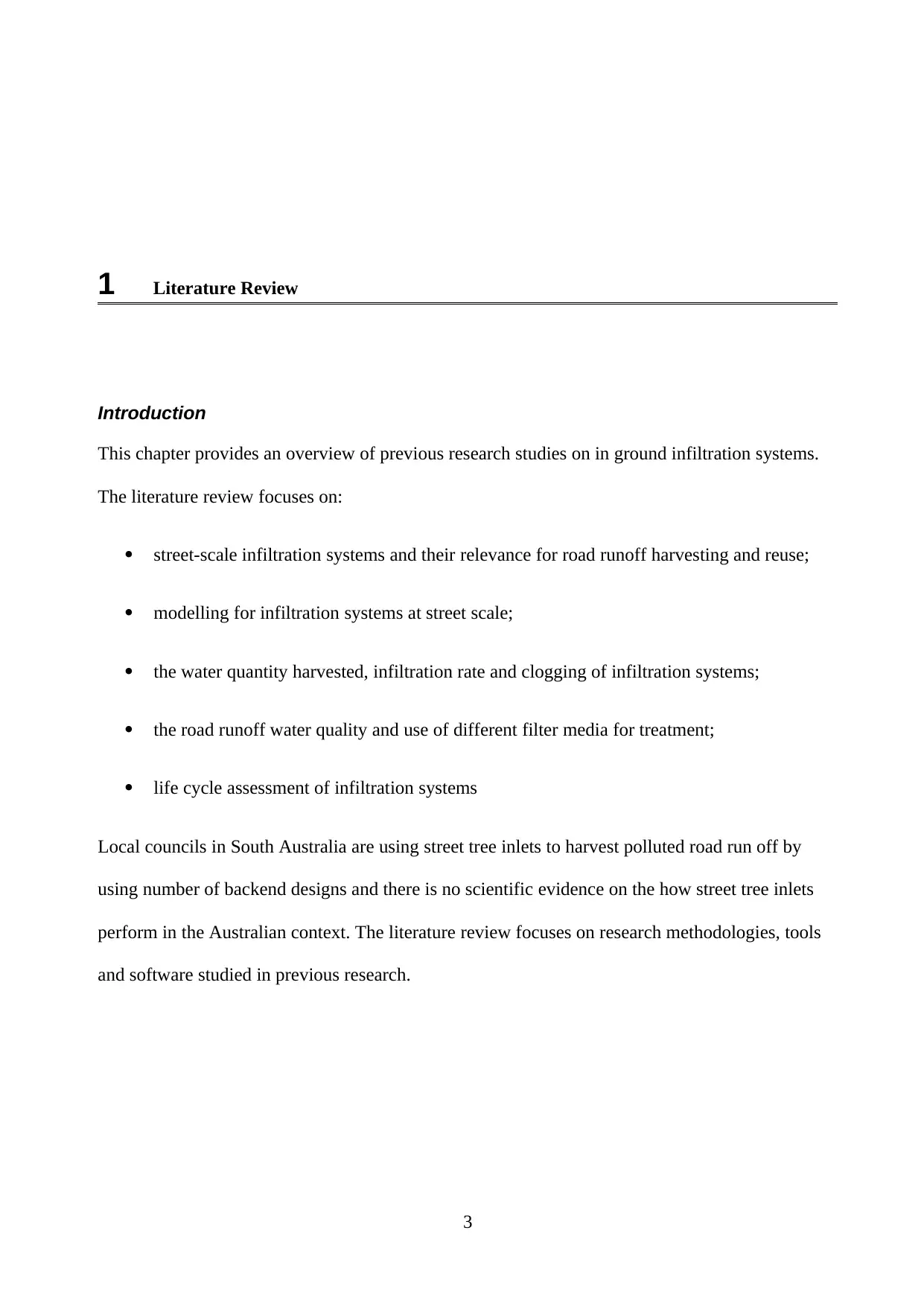
1 Literature Review
Introduction
This chapter provides an overview of previous research studies on in ground infiltration systems.
The literature review focuses on:
street-scale infiltration systems and their relevance for road runoff harvesting and reuse;
modelling for infiltration systems at street scale;
the water quantity harvested, infiltration rate and clogging of infiltration systems;
the road runoff water quality and use of different filter media for treatment;
life cycle assessment of infiltration systems
Local councils in South Australia are using street tree inlets to harvest polluted road run off by
using number of backend designs and there is no scientific evidence on the how street tree inlets
perform in the Australian context. The literature review focuses on research methodologies, tools
and software studied in previous research.
3
Introduction
This chapter provides an overview of previous research studies on in ground infiltration systems.
The literature review focuses on:
street-scale infiltration systems and their relevance for road runoff harvesting and reuse;
modelling for infiltration systems at street scale;
the water quantity harvested, infiltration rate and clogging of infiltration systems;
the road runoff water quality and use of different filter media for treatment;
life cycle assessment of infiltration systems
Local councils in South Australia are using street tree inlets to harvest polluted road run off by
using number of backend designs and there is no scientific evidence on the how street tree inlets
perform in the Australian context. The literature review focuses on research methodologies, tools
and software studied in previous research.
3
⊘ This is a preview!⊘
Do you want full access?
Subscribe today to unlock all pages.

Trusted by 1+ million students worldwide
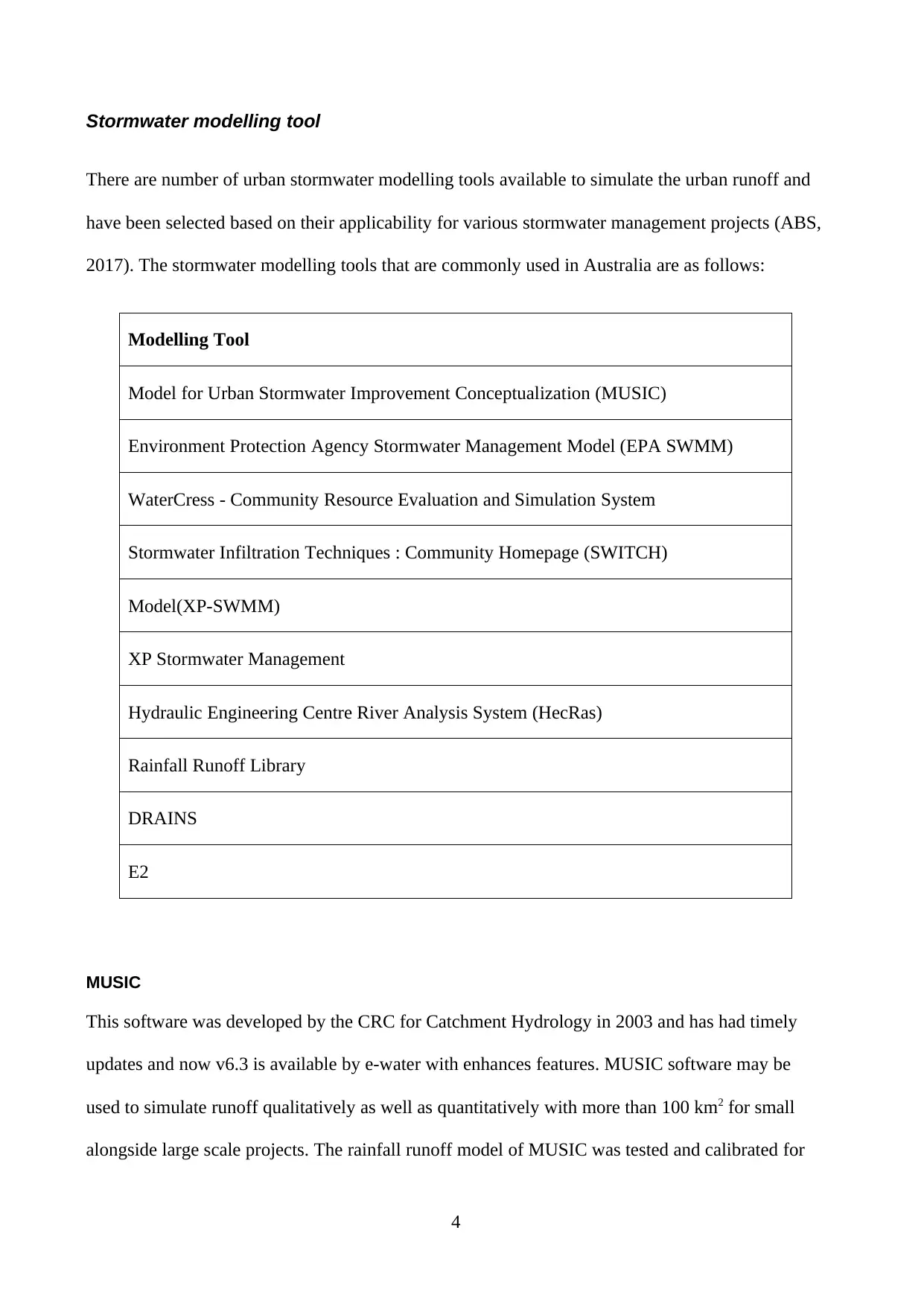
Stormwater modelling tool
There are number of urban stormwater modelling tools available to simulate the urban runoff and
have been selected based on their applicability for various stormwater management projects (ABS,
2017). The stormwater modelling tools that are commonly used in Australia are as follows:
Modelling Tool
Model for Urban Stormwater Improvement Conceptualization (MUSIC)
Environment Protection Agency Stormwater Management Model (EPA SWMM)
WaterCress - Community Resource Evaluation and Simulation System
Stormwater Infiltration Techniques : Community Homepage (SWITCH)
Model(XP-SWMM)
XP Stormwater Management
Hydraulic Engineering Centre River Analysis System (HecRas)
Rainfall Runoff Library
DRAINS
E2
MUSIC
This software was developed by the CRC for Catchment Hydrology in 2003 and has had timely
updates and now v6.3 is available by e-water with enhances features. MUSIC software may be
used to simulate runoff qualitatively as well as quantitatively with more than 100 km2 for small
alongside large scale projects. The rainfall runoff model of MUSIC was tested and calibrated for
4
There are number of urban stormwater modelling tools available to simulate the urban runoff and
have been selected based on their applicability for various stormwater management projects (ABS,
2017). The stormwater modelling tools that are commonly used in Australia are as follows:
Modelling Tool
Model for Urban Stormwater Improvement Conceptualization (MUSIC)
Environment Protection Agency Stormwater Management Model (EPA SWMM)
WaterCress - Community Resource Evaluation and Simulation System
Stormwater Infiltration Techniques : Community Homepage (SWITCH)
Model(XP-SWMM)
XP Stormwater Management
Hydraulic Engineering Centre River Analysis System (HecRas)
Rainfall Runoff Library
DRAINS
E2
MUSIC
This software was developed by the CRC for Catchment Hydrology in 2003 and has had timely
updates and now v6.3 is available by e-water with enhances features. MUSIC software may be
used to simulate runoff qualitatively as well as quantitatively with more than 100 km2 for small
alongside large scale projects. The rainfall runoff model of MUSIC was tested and calibrated for
4
Paraphrase This Document
Need a fresh take? Get an instant paraphrase of this document with our AI Paraphraser
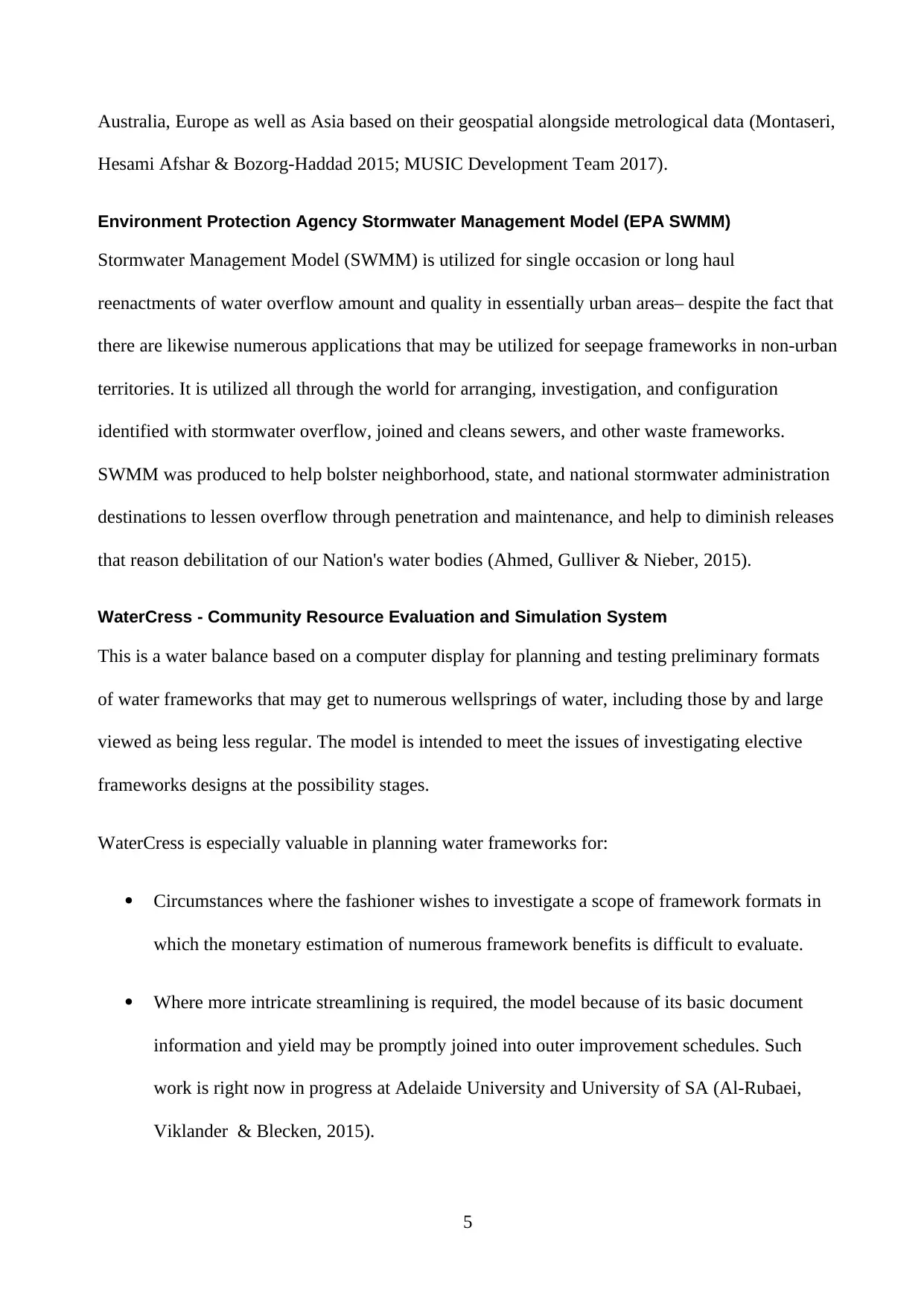
Australia, Europe as well as Asia based on their geospatial alongside metrological data (Montaseri,
Hesami Afshar & Bozorg-Haddad 2015; MUSIC Development Team 2017).
Environment Protection Agency Stormwater Management Model (EPA SWMM)
Stormwater Management Model (SWMM) is utilized for single occasion or long haul
reenactments of water overflow amount and quality in essentially urban areas– despite the fact that
there are likewise numerous applications that may be utilized for seepage frameworks in non-urban
territories. It is utilized all through the world for arranging, investigation, and configuration
identified with stormwater overflow, joined and cleans sewers, and other waste frameworks.
SWMM was produced to help bolster neighborhood, state, and national stormwater administration
destinations to lessen overflow through penetration and maintenance, and help to diminish releases
that reason debilitation of our Nation's water bodies (Ahmed, Gulliver & Nieber, 2015).
WaterCress - Community Resource Evaluation and Simulation System
This is a water balance based on a computer display for planning and testing preliminary formats
of water frameworks that may get to numerous wellsprings of water, including those by and large
viewed as being less regular. The model is intended to meet the issues of investigating elective
frameworks designs at the possibility stages.
WaterCress is especially valuable in planning water frameworks for:
Circumstances where the fashioner wishes to investigate a scope of framework formats in
which the monetary estimation of numerous framework benefits is difficult to evaluate.
Where more intricate streamlining is required, the model because of its basic document
information and yield may be promptly joined into outer improvement schedules. Such
work is right now in progress at Adelaide University and University of SA (Al-Rubaei,
Viklander & Blecken, 2015).
5
Hesami Afshar & Bozorg-Haddad 2015; MUSIC Development Team 2017).
Environment Protection Agency Stormwater Management Model (EPA SWMM)
Stormwater Management Model (SWMM) is utilized for single occasion or long haul
reenactments of water overflow amount and quality in essentially urban areas– despite the fact that
there are likewise numerous applications that may be utilized for seepage frameworks in non-urban
territories. It is utilized all through the world for arranging, investigation, and configuration
identified with stormwater overflow, joined and cleans sewers, and other waste frameworks.
SWMM was produced to help bolster neighborhood, state, and national stormwater administration
destinations to lessen overflow through penetration and maintenance, and help to diminish releases
that reason debilitation of our Nation's water bodies (Ahmed, Gulliver & Nieber, 2015).
WaterCress - Community Resource Evaluation and Simulation System
This is a water balance based on a computer display for planning and testing preliminary formats
of water frameworks that may get to numerous wellsprings of water, including those by and large
viewed as being less regular. The model is intended to meet the issues of investigating elective
frameworks designs at the possibility stages.
WaterCress is especially valuable in planning water frameworks for:
Circumstances where the fashioner wishes to investigate a scope of framework formats in
which the monetary estimation of numerous framework benefits is difficult to evaluate.
Where more intricate streamlining is required, the model because of its basic document
information and yield may be promptly joined into outer improvement schedules. Such
work is right now in progress at Adelaide University and University of SA (Al-Rubaei,
Viklander & Blecken, 2015).
5
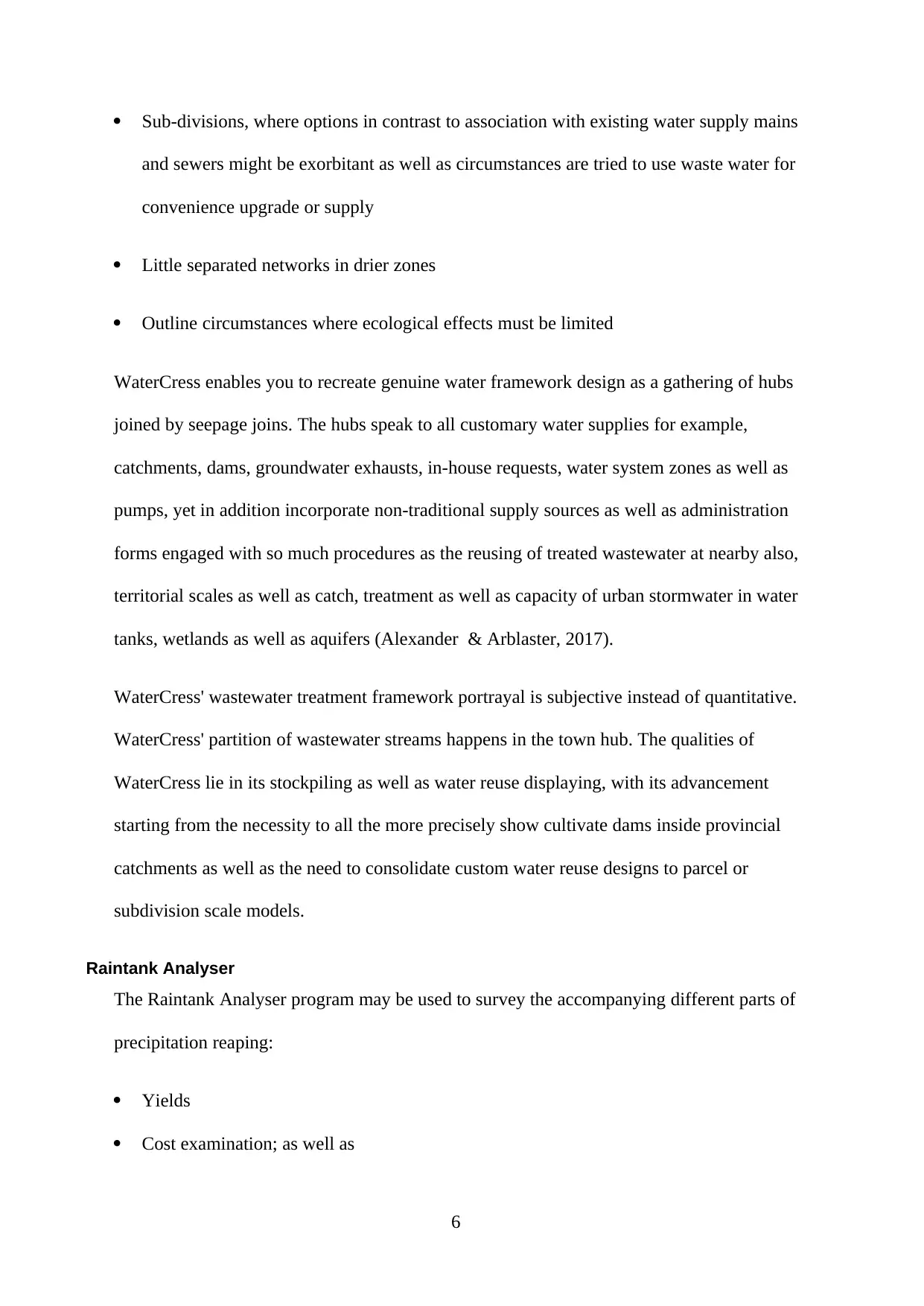
Sub-divisions, where options in contrast to association with existing water supply mains
and sewers might be exorbitant as well as circumstances are tried to use waste water for
convenience upgrade or supply
Little separated networks in drier zones
Outline circumstances where ecological effects must be limited
WaterCress enables you to recreate genuine water framework design as a gathering of hubs
joined by seepage joins. The hubs speak to all customary water supplies for example,
catchments, dams, groundwater exhausts, in-house requests, water system zones as well as
pumps, yet in addition incorporate non-traditional supply sources as well as administration
forms engaged with so much procedures as the reusing of treated wastewater at nearby also,
territorial scales as well as catch, treatment as well as capacity of urban stormwater in water
tanks, wetlands as well as aquifers (Alexander & Arblaster, 2017).
WaterCress' wastewater treatment framework portrayal is subjective instead of quantitative.
WaterCress' partition of wastewater streams happens in the town hub. The qualities of
WaterCress lie in its stockpiling as well as water reuse displaying, with its advancement
starting from the necessity to all the more precisely show cultivate dams inside provincial
catchments as well as the need to consolidate custom water reuse designs to parcel or
subdivision scale models.
Raintank Analyser
The Raintank Analyser program may be used to survey the accompanying different parts of
precipitation reaping:
Yields
Cost examination; as well as
6
and sewers might be exorbitant as well as circumstances are tried to use waste water for
convenience upgrade or supply
Little separated networks in drier zones
Outline circumstances where ecological effects must be limited
WaterCress enables you to recreate genuine water framework design as a gathering of hubs
joined by seepage joins. The hubs speak to all customary water supplies for example,
catchments, dams, groundwater exhausts, in-house requests, water system zones as well as
pumps, yet in addition incorporate non-traditional supply sources as well as administration
forms engaged with so much procedures as the reusing of treated wastewater at nearby also,
territorial scales as well as catch, treatment as well as capacity of urban stormwater in water
tanks, wetlands as well as aquifers (Alexander & Arblaster, 2017).
WaterCress' wastewater treatment framework portrayal is subjective instead of quantitative.
WaterCress' partition of wastewater streams happens in the town hub. The qualities of
WaterCress lie in its stockpiling as well as water reuse displaying, with its advancement
starting from the necessity to all the more precisely show cultivate dams inside provincial
catchments as well as the need to consolidate custom water reuse designs to parcel or
subdivision scale models.
Raintank Analyser
The Raintank Analyser program may be used to survey the accompanying different parts of
precipitation reaping:
Yields
Cost examination; as well as
6
⊘ This is a preview!⊘
Do you want full access?
Subscribe today to unlock all pages.

Trusted by 1+ million students worldwide
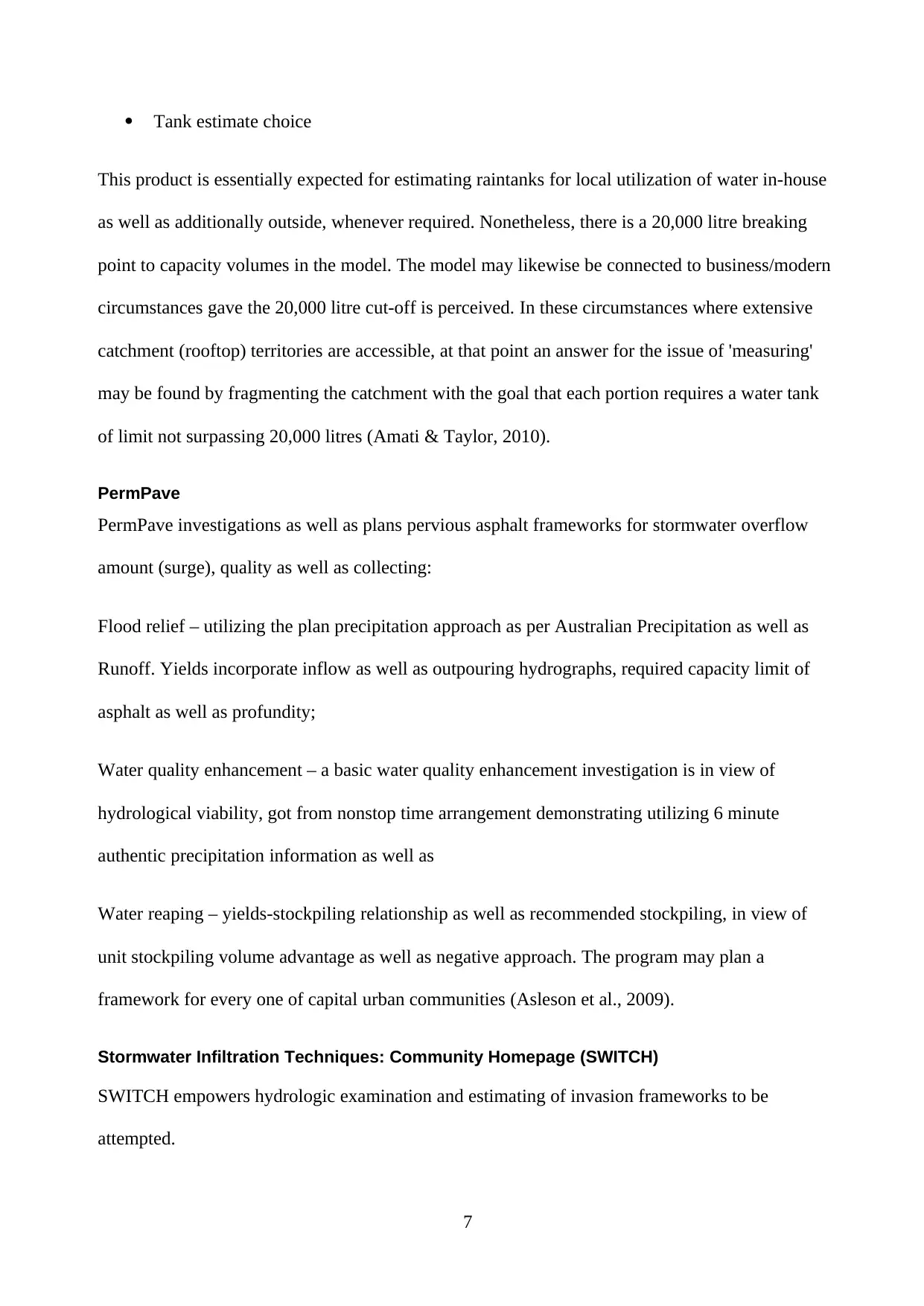
Tank estimate choice
This product is essentially expected for estimating raintanks for local utilization of water in-house
as well as additionally outside, whenever required. Nonetheless, there is a 20,000 litre breaking
point to capacity volumes in the model. The model may likewise be connected to business/modern
circumstances gave the 20,000 litre cut-off is perceived. In these circumstances where extensive
catchment (rooftop) territories are accessible, at that point an answer for the issue of 'measuring'
may be found by fragmenting the catchment with the goal that each portion requires a water tank
of limit not surpassing 20,000 litres (Amati & Taylor, 2010).
PermPave
PermPave investigations as well as plans pervious asphalt frameworks for stormwater overflow
amount (surge), quality as well as collecting:
Flood relief – utilizing the plan precipitation approach as per Australian Precipitation as well as
Runoff. Yields incorporate inflow as well as outpouring hydrographs, required capacity limit of
asphalt as well as profundity;
Water quality enhancement – a basic water quality enhancement investigation is in view of
hydrological viability, got from nonstop time arrangement demonstrating utilizing 6 minute
authentic precipitation information as well as
Water reaping – yields-stockpiling relationship as well as recommended stockpiling, in view of
unit stockpiling volume advantage as well as negative approach. The program may plan a
framework for every one of capital urban communities (Asleson et al., 2009).
Stormwater Infiltration Techniques: Community Homepage (SWITCH)
SWITCH empowers hydrologic examination and estimating of invasion frameworks to be
attempted.
7
This product is essentially expected for estimating raintanks for local utilization of water in-house
as well as additionally outside, whenever required. Nonetheless, there is a 20,000 litre breaking
point to capacity volumes in the model. The model may likewise be connected to business/modern
circumstances gave the 20,000 litre cut-off is perceived. In these circumstances where extensive
catchment (rooftop) territories are accessible, at that point an answer for the issue of 'measuring'
may be found by fragmenting the catchment with the goal that each portion requires a water tank
of limit not surpassing 20,000 litres (Amati & Taylor, 2010).
PermPave
PermPave investigations as well as plans pervious asphalt frameworks for stormwater overflow
amount (surge), quality as well as collecting:
Flood relief – utilizing the plan precipitation approach as per Australian Precipitation as well as
Runoff. Yields incorporate inflow as well as outpouring hydrographs, required capacity limit of
asphalt as well as profundity;
Water quality enhancement – a basic water quality enhancement investigation is in view of
hydrological viability, got from nonstop time arrangement demonstrating utilizing 6 minute
authentic precipitation information as well as
Water reaping – yields-stockpiling relationship as well as recommended stockpiling, in view of
unit stockpiling volume advantage as well as negative approach. The program may plan a
framework for every one of capital urban communities (Asleson et al., 2009).
Stormwater Infiltration Techniques: Community Homepage (SWITCH)
SWITCH empowers hydrologic examination and estimating of invasion frameworks to be
attempted.
7
Paraphrase This Document
Need a fresh take? Get an instant paraphrase of this document with our AI Paraphraser
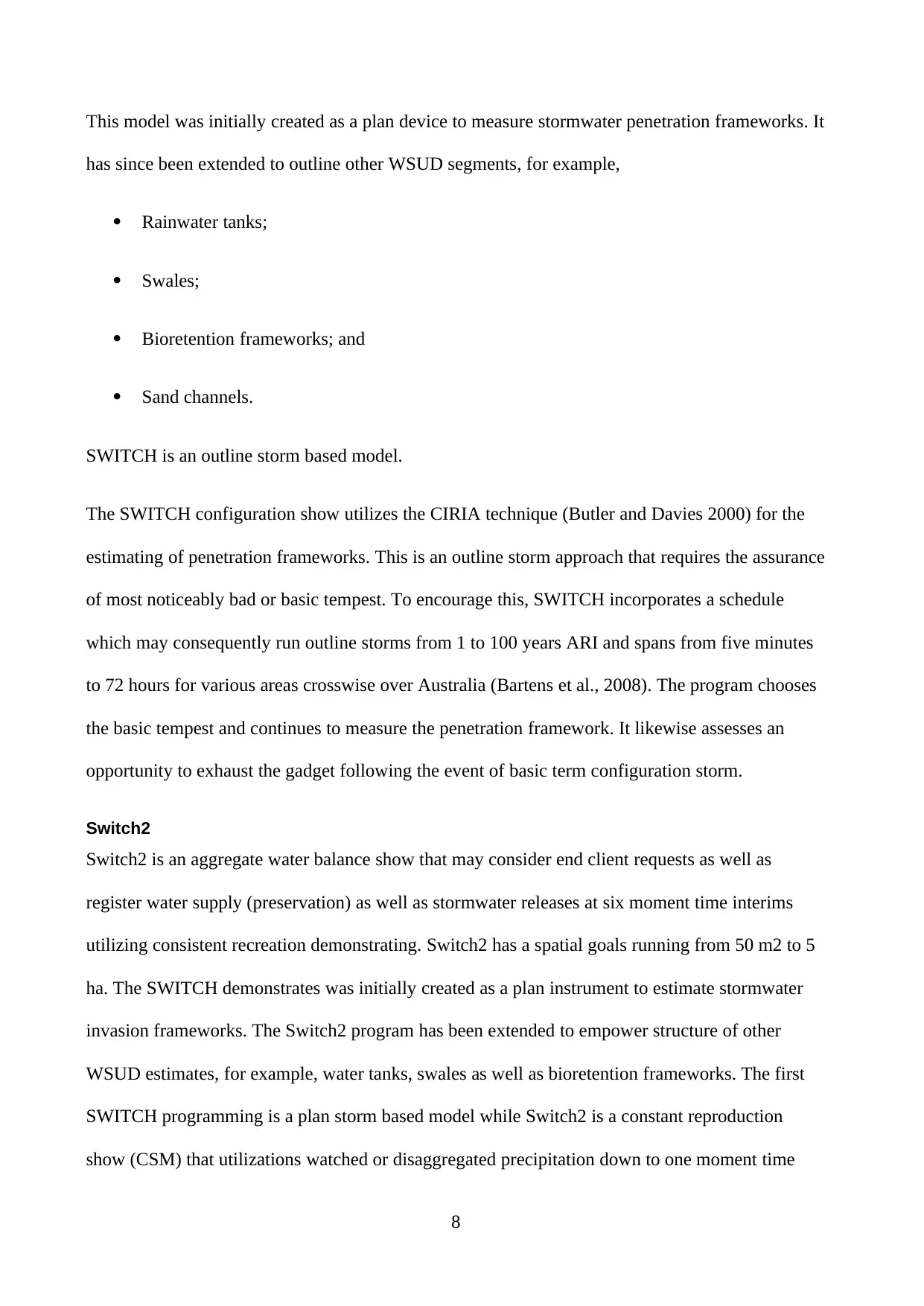
This model was initially created as a plan device to measure stormwater penetration frameworks. It
has since been extended to outline other WSUD segments, for example,
Rainwater tanks;
Swales;
Bioretention frameworks; and
Sand channels.
SWITCH is an outline storm based model.
The SWITCH configuration show utilizes the CIRIA technique (Butler and Davies 2000) for the
estimating of penetration frameworks. This is an outline storm approach that requires the assurance
of most noticeably bad or basic tempest. To encourage this, SWITCH incorporates a schedule
which may consequently run outline storms from 1 to 100 years ARI and spans from five minutes
to 72 hours for various areas crosswise over Australia (Bartens et al., 2008). The program chooses
the basic tempest and continues to measure the penetration framework. It likewise assesses an
opportunity to exhaust the gadget following the event of basic term configuration storm.
Switch2
Switch2 is an aggregate water balance show that may consider end client requests as well as
register water supply (preservation) as well as stormwater releases at six moment time interims
utilizing consistent recreation demonstrating. Switch2 has a spatial goals running from 50 m2 to 5
ha. The SWITCH demonstrates was initially created as a plan instrument to estimate stormwater
invasion frameworks. The Switch2 program has been extended to empower structure of other
WSUD estimates, for example, water tanks, swales as well as bioretention frameworks. The first
SWITCH programming is a plan storm based model while Switch2 is a constant reproduction
show (CSM) that utilizations watched or disaggregated precipitation down to one moment time
8
has since been extended to outline other WSUD segments, for example,
Rainwater tanks;
Swales;
Bioretention frameworks; and
Sand channels.
SWITCH is an outline storm based model.
The SWITCH configuration show utilizes the CIRIA technique (Butler and Davies 2000) for the
estimating of penetration frameworks. This is an outline storm approach that requires the assurance
of most noticeably bad or basic tempest. To encourage this, SWITCH incorporates a schedule
which may consequently run outline storms from 1 to 100 years ARI and spans from five minutes
to 72 hours for various areas crosswise over Australia (Bartens et al., 2008). The program chooses
the basic tempest and continues to measure the penetration framework. It likewise assesses an
opportunity to exhaust the gadget following the event of basic term configuration storm.
Switch2
Switch2 is an aggregate water balance show that may consider end client requests as well as
register water supply (preservation) as well as stormwater releases at six moment time interims
utilizing consistent recreation demonstrating. Switch2 has a spatial goals running from 50 m2 to 5
ha. The SWITCH demonstrates was initially created as a plan instrument to estimate stormwater
invasion frameworks. The Switch2 program has been extended to empower structure of other
WSUD estimates, for example, water tanks, swales as well as bioretention frameworks. The first
SWITCH programming is a plan storm based model while Switch2 is a constant reproduction
show (CSM) that utilizations watched or disaggregated precipitation down to one moment time
8
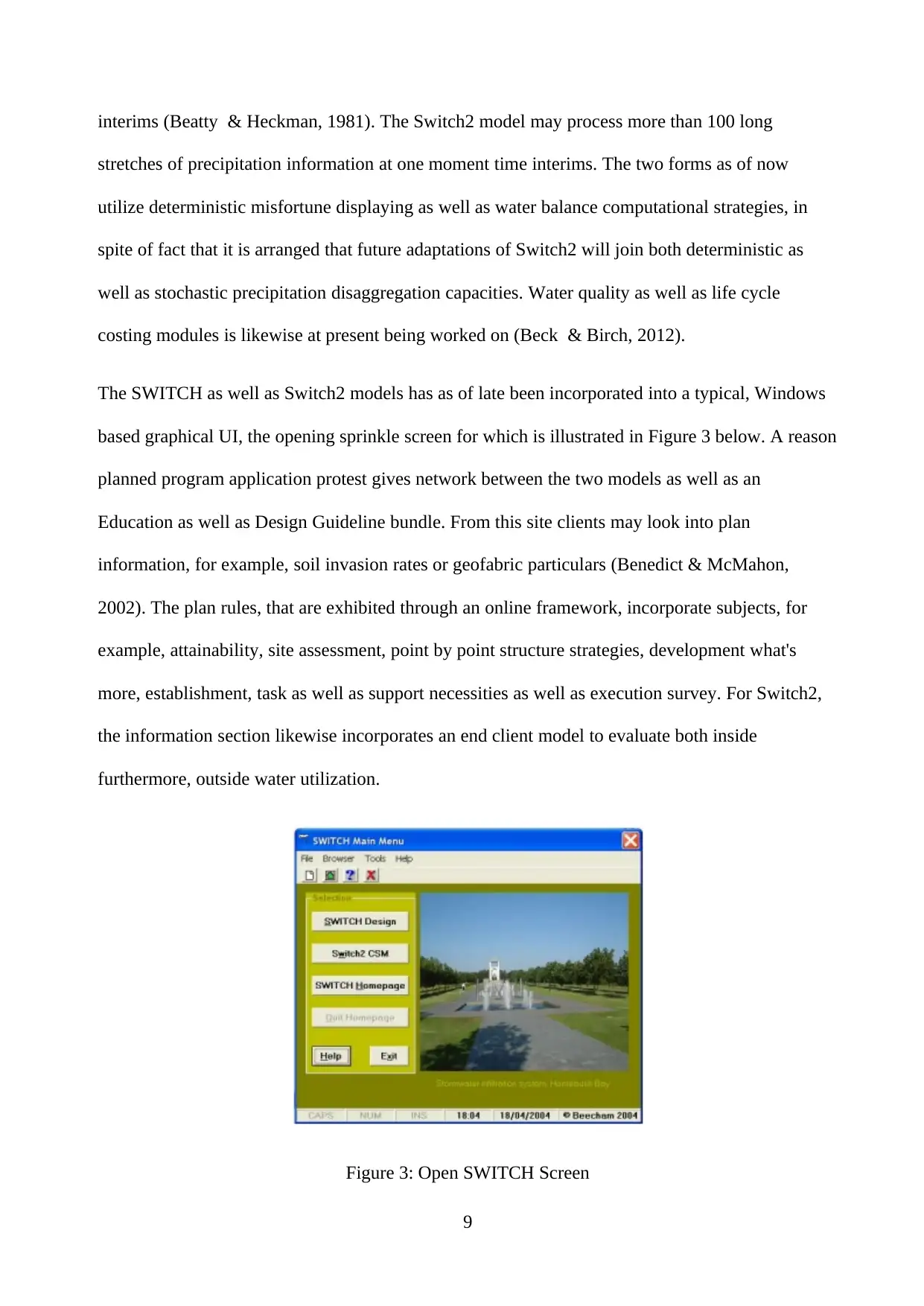
interims (Beatty & Heckman, 1981). The Switch2 model may process more than 100 long
stretches of precipitation information at one moment time interims. The two forms as of now
utilize deterministic misfortune displaying as well as water balance computational strategies, in
spite of fact that it is arranged that future adaptations of Switch2 will join both deterministic as
well as stochastic precipitation disaggregation capacities. Water quality as well as life cycle
costing modules is likewise at present being worked on (Beck & Birch, 2012).
The SWITCH as well as Switch2 models has as of late been incorporated into a typical, Windows
based graphical UI, the opening sprinkle screen for which is illustrated in Figure 3 below. A reason
planned program application protest gives network between the two models as well as an
Education as well as Design Guideline bundle. From this site clients may look into plan
information, for example, soil invasion rates or geofabric particulars (Benedict & McMahon,
2002). The plan rules, that are exhibited through an online framework, incorporate subjects, for
example, attainability, site assessment, point by point structure strategies, development what's
more, establishment, task as well as support necessities as well as execution survey. For Switch2,
the information section likewise incorporates an end client model to evaluate both inside
furthermore, outside water utilization.
Figure 3: Open SWITCH Screen
9
stretches of precipitation information at one moment time interims. The two forms as of now
utilize deterministic misfortune displaying as well as water balance computational strategies, in
spite of fact that it is arranged that future adaptations of Switch2 will join both deterministic as
well as stochastic precipitation disaggregation capacities. Water quality as well as life cycle
costing modules is likewise at present being worked on (Beck & Birch, 2012).
The SWITCH as well as Switch2 models has as of late been incorporated into a typical, Windows
based graphical UI, the opening sprinkle screen for which is illustrated in Figure 3 below. A reason
planned program application protest gives network between the two models as well as an
Education as well as Design Guideline bundle. From this site clients may look into plan
information, for example, soil invasion rates or geofabric particulars (Benedict & McMahon,
2002). The plan rules, that are exhibited through an online framework, incorporate subjects, for
example, attainability, site assessment, point by point structure strategies, development what's
more, establishment, task as well as support necessities as well as execution survey. For Switch2,
the information section likewise incorporates an end client model to evaluate both inside
furthermore, outside water utilization.
Figure 3: Open SWITCH Screen
9
⊘ This is a preview!⊘
Do you want full access?
Subscribe today to unlock all pages.

Trusted by 1+ million students worldwide
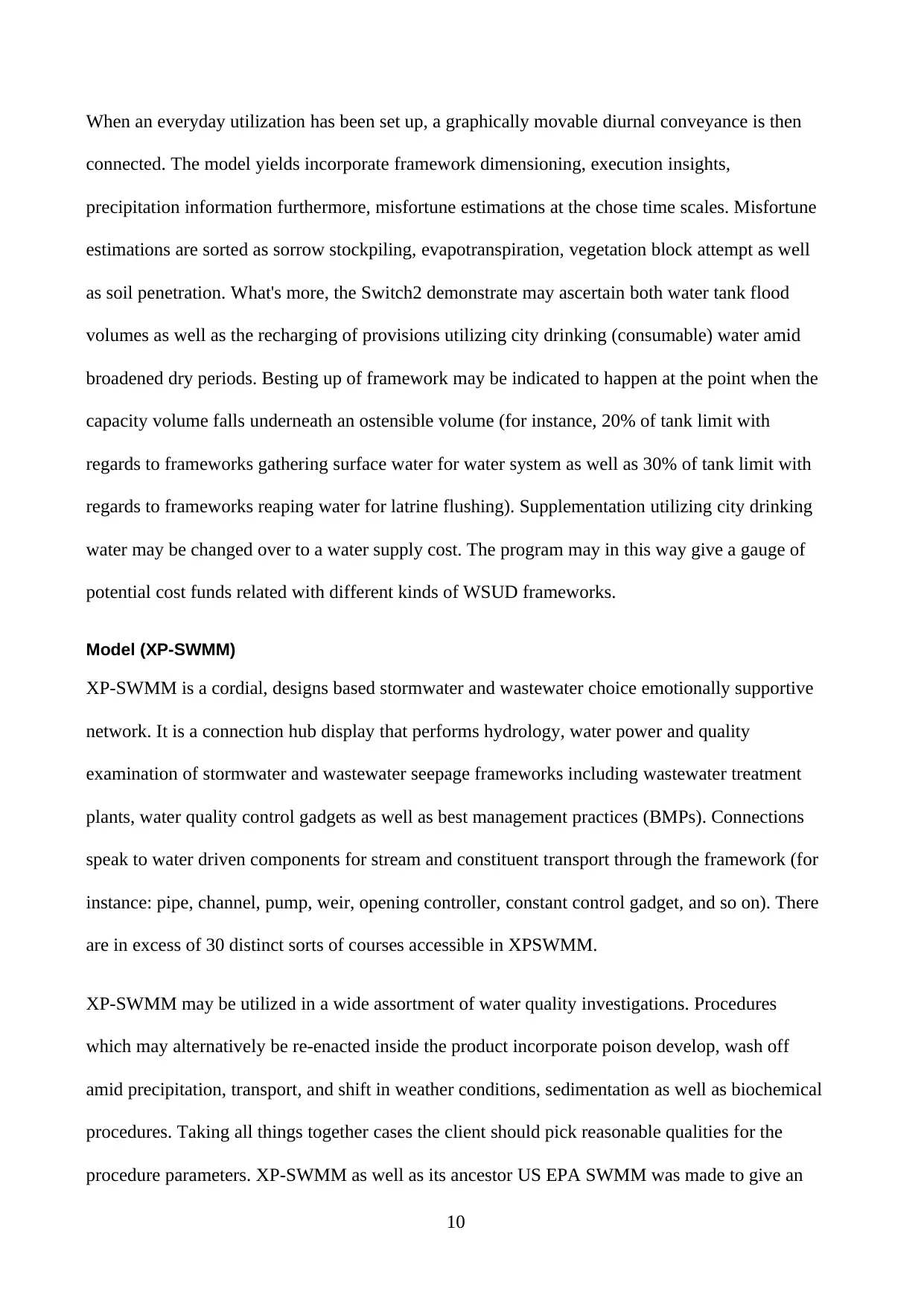
When an everyday utilization has been set up, a graphically movable diurnal conveyance is then
connected. The model yields incorporate framework dimensioning, execution insights,
precipitation information furthermore, misfortune estimations at the chose time scales. Misfortune
estimations are sorted as sorrow stockpiling, evapotranspiration, vegetation block attempt as well
as soil penetration. What's more, the Switch2 demonstrate may ascertain both water tank flood
volumes as well as the recharging of provisions utilizing city drinking (consumable) water amid
broadened dry periods. Besting up of framework may be indicated to happen at the point when the
capacity volume falls underneath an ostensible volume (for instance, 20% of tank limit with
regards to frameworks gathering surface water for water system as well as 30% of tank limit with
regards to frameworks reaping water for latrine flushing). Supplementation utilizing city drinking
water may be changed over to a water supply cost. The program may in this way give a gauge of
potential cost funds related with different kinds of WSUD frameworks.
Model (XP-SWMM)
XP-SWMM is a cordial, designs based stormwater and wastewater choice emotionally supportive
network. It is a connection hub display that performs hydrology, water power and quality
examination of stormwater and wastewater seepage frameworks including wastewater treatment
plants, water quality control gadgets as well as best management practices (BMPs). Connections
speak to water driven components for stream and constituent transport through the framework (for
instance: pipe, channel, pump, weir, opening controller, constant control gadget, and so on). There
are in excess of 30 distinct sorts of courses accessible in XPSWMM.
XP-SWMM may be utilized in a wide assortment of water quality investigations. Procedures
which may alternatively be re-enacted inside the product incorporate poison develop, wash off
amid precipitation, transport, and shift in weather conditions, sedimentation as well as biochemical
procedures. Taking all things together cases the client should pick reasonable qualities for the
procedure parameters. XP-SWMM as well as its ancestor US EPA SWMM was made to give an
10
connected. The model yields incorporate framework dimensioning, execution insights,
precipitation information furthermore, misfortune estimations at the chose time scales. Misfortune
estimations are sorted as sorrow stockpiling, evapotranspiration, vegetation block attempt as well
as soil penetration. What's more, the Switch2 demonstrate may ascertain both water tank flood
volumes as well as the recharging of provisions utilizing city drinking (consumable) water amid
broadened dry periods. Besting up of framework may be indicated to happen at the point when the
capacity volume falls underneath an ostensible volume (for instance, 20% of tank limit with
regards to frameworks gathering surface water for water system as well as 30% of tank limit with
regards to frameworks reaping water for latrine flushing). Supplementation utilizing city drinking
water may be changed over to a water supply cost. The program may in this way give a gauge of
potential cost funds related with different kinds of WSUD frameworks.
Model (XP-SWMM)
XP-SWMM is a cordial, designs based stormwater and wastewater choice emotionally supportive
network. It is a connection hub display that performs hydrology, water power and quality
examination of stormwater and wastewater seepage frameworks including wastewater treatment
plants, water quality control gadgets as well as best management practices (BMPs). Connections
speak to water driven components for stream and constituent transport through the framework (for
instance: pipe, channel, pump, weir, opening controller, constant control gadget, and so on). There
are in excess of 30 distinct sorts of courses accessible in XPSWMM.
XP-SWMM may be utilized in a wide assortment of water quality investigations. Procedures
which may alternatively be re-enacted inside the product incorporate poison develop, wash off
amid precipitation, transport, and shift in weather conditions, sedimentation as well as biochemical
procedures. Taking all things together cases the client should pick reasonable qualities for the
procedure parameters. XP-SWMM as well as its ancestor US EPA SWMM was made to give an
10
Paraphrase This Document
Need a fresh take? Get an instant paraphrase of this document with our AI Paraphraser
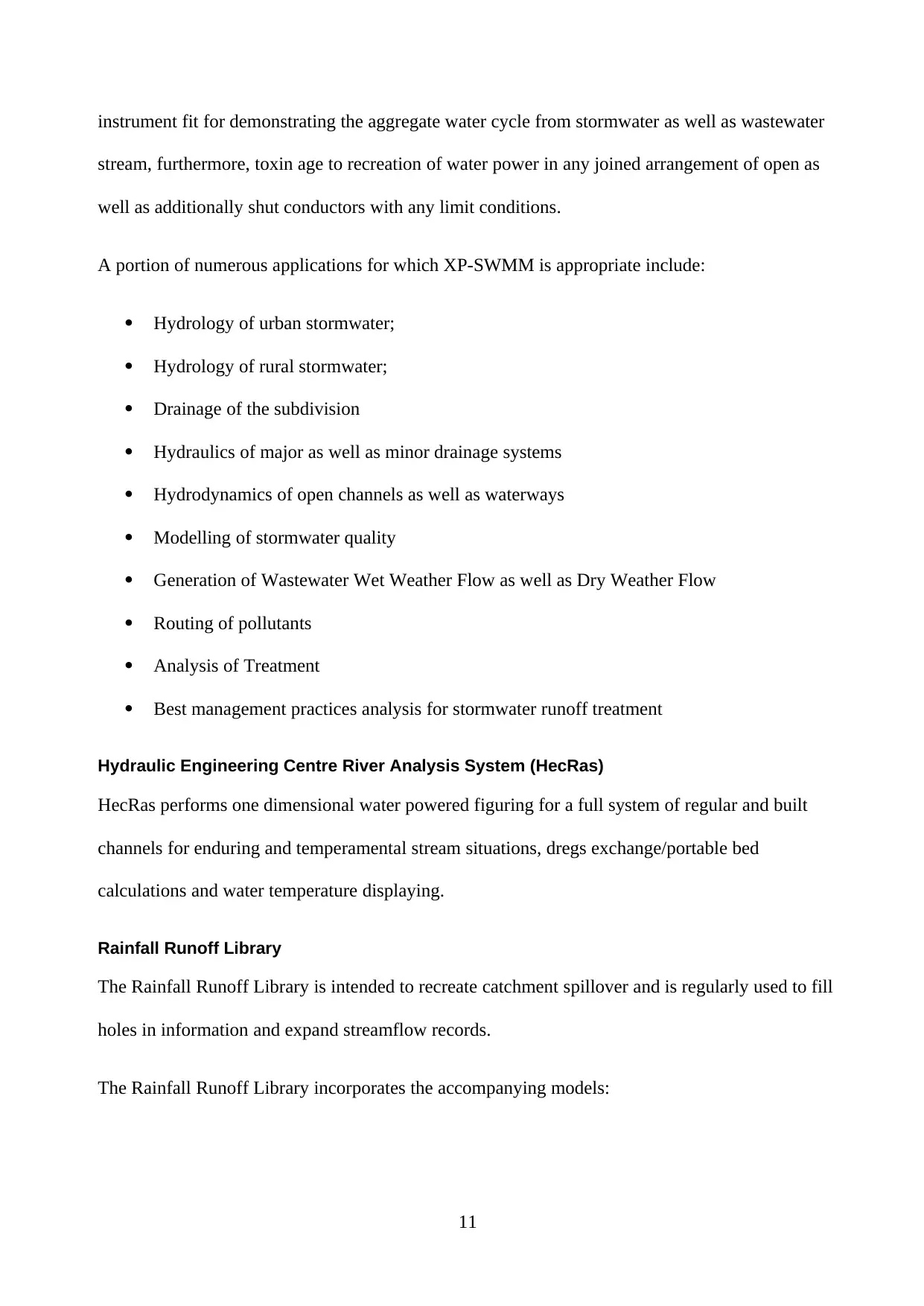
instrument fit for demonstrating the aggregate water cycle from stormwater as well as wastewater
stream, furthermore, toxin age to recreation of water power in any joined arrangement of open as
well as additionally shut conductors with any limit conditions.
A portion of numerous applications for which XP-SWMM is appropriate include:
Hydrology of urban stormwater;
Hydrology of rural stormwater;
Drainage of the subdivision
Hydraulics of major as well as minor drainage systems
Hydrodynamics of open channels as well as waterways
Modelling of stormwater quality
Generation of Wastewater Wet Weather Flow as well as Dry Weather Flow
Routing of pollutants
Analysis of Treatment
Best management practices analysis for stormwater runoff treatment
Hydraulic Engineering Centre River Analysis System (HecRas)
HecRas performs one dimensional water powered figuring for a full system of regular and built
channels for enduring and temperamental stream situations, dregs exchange/portable bed
calculations and water temperature displaying.
Rainfall Runoff Library
The Rainfall Runoff Library is intended to recreate catchment spillover and is regularly used to fill
holes in information and expand streamflow records.
The Rainfall Runoff Library incorporates the accompanying models:
11
stream, furthermore, toxin age to recreation of water power in any joined arrangement of open as
well as additionally shut conductors with any limit conditions.
A portion of numerous applications for which XP-SWMM is appropriate include:
Hydrology of urban stormwater;
Hydrology of rural stormwater;
Drainage of the subdivision
Hydraulics of major as well as minor drainage systems
Hydrodynamics of open channels as well as waterways
Modelling of stormwater quality
Generation of Wastewater Wet Weather Flow as well as Dry Weather Flow
Routing of pollutants
Analysis of Treatment
Best management practices analysis for stormwater runoff treatment
Hydraulic Engineering Centre River Analysis System (HecRas)
HecRas performs one dimensional water powered figuring for a full system of regular and built
channels for enduring and temperamental stream situations, dregs exchange/portable bed
calculations and water temperature displaying.
Rainfall Runoff Library
The Rainfall Runoff Library is intended to recreate catchment spillover and is regularly used to fill
holes in information and expand streamflow records.
The Rainfall Runoff Library incorporates the accompanying models:
11
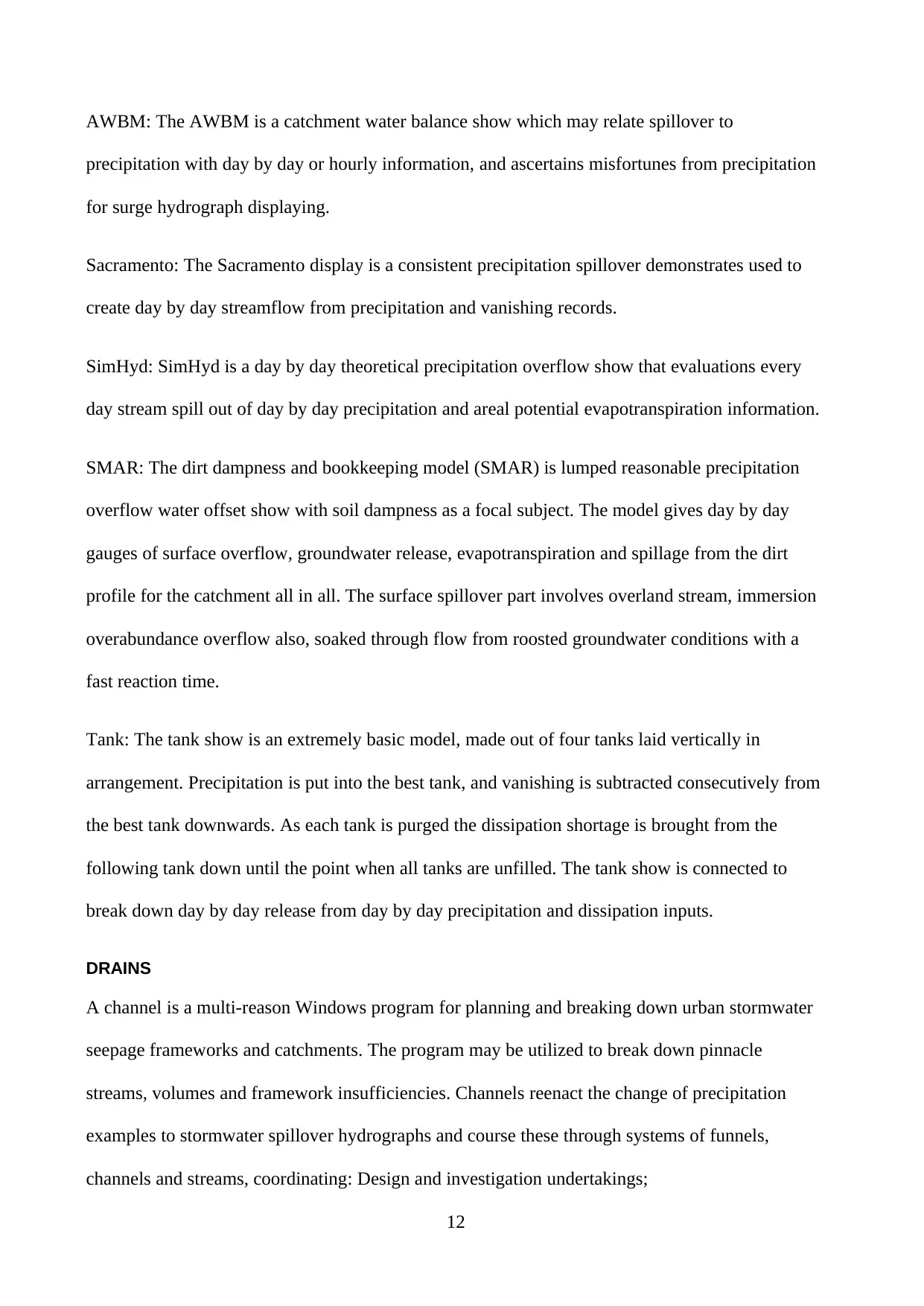
AWBM: The AWBM is a catchment water balance show which may relate spillover to
precipitation with day by day or hourly information, and ascertains misfortunes from precipitation
for surge hydrograph displaying.
Sacramento: The Sacramento display is a consistent precipitation spillover demonstrates used to
create day by day streamflow from precipitation and vanishing records.
SimHyd: SimHyd is a day by day theoretical precipitation overflow show that evaluations every
day stream spill out of day by day precipitation and areal potential evapotranspiration information.
SMAR: The dirt dampness and bookkeeping model (SMAR) is lumped reasonable precipitation
overflow water offset show with soil dampness as a focal subject. The model gives day by day
gauges of surface overflow, groundwater release, evapotranspiration and spillage from the dirt
profile for the catchment all in all. The surface spillover part involves overland stream, immersion
overabundance overflow also, soaked through flow from roosted groundwater conditions with a
fast reaction time.
Tank: The tank show is an extremely basic model, made out of four tanks laid vertically in
arrangement. Precipitation is put into the best tank, and vanishing is subtracted consecutively from
the best tank downwards. As each tank is purged the dissipation shortage is brought from the
following tank down until the point when all tanks are unfilled. The tank show is connected to
break down day by day release from day by day precipitation and dissipation inputs.
DRAINS
A channel is a multi-reason Windows program for planning and breaking down urban stormwater
seepage frameworks and catchments. The program may be utilized to break down pinnacle
streams, volumes and framework insufficiencies. Channels reenact the change of precipitation
examples to stormwater spillover hydrographs and course these through systems of funnels,
channels and streams, coordinating: Design and investigation undertakings;
12
precipitation with day by day or hourly information, and ascertains misfortunes from precipitation
for surge hydrograph displaying.
Sacramento: The Sacramento display is a consistent precipitation spillover demonstrates used to
create day by day streamflow from precipitation and vanishing records.
SimHyd: SimHyd is a day by day theoretical precipitation overflow show that evaluations every
day stream spill out of day by day precipitation and areal potential evapotranspiration information.
SMAR: The dirt dampness and bookkeeping model (SMAR) is lumped reasonable precipitation
overflow water offset show with soil dampness as a focal subject. The model gives day by day
gauges of surface overflow, groundwater release, evapotranspiration and spillage from the dirt
profile for the catchment all in all. The surface spillover part involves overland stream, immersion
overabundance overflow also, soaked through flow from roosted groundwater conditions with a
fast reaction time.
Tank: The tank show is an extremely basic model, made out of four tanks laid vertically in
arrangement. Precipitation is put into the best tank, and vanishing is subtracted consecutively from
the best tank downwards. As each tank is purged the dissipation shortage is brought from the
following tank down until the point when all tanks are unfilled. The tank show is connected to
break down day by day release from day by day precipitation and dissipation inputs.
DRAINS
A channel is a multi-reason Windows program for planning and breaking down urban stormwater
seepage frameworks and catchments. The program may be utilized to break down pinnacle
streams, volumes and framework insufficiencies. Channels reenact the change of precipitation
examples to stormwater spillover hydrographs and course these through systems of funnels,
channels and streams, coordinating: Design and investigation undertakings;
12
⊘ This is a preview!⊘
Do you want full access?
Subscribe today to unlock all pages.

Trusted by 1+ million students worldwide
1 out of 42
Your All-in-One AI-Powered Toolkit for Academic Success.
+13062052269
info@desklib.com
Available 24*7 on WhatsApp / Email
![[object Object]](/_next/static/media/star-bottom.7253800d.svg)
Unlock your academic potential
Copyright © 2020–2025 A2Z Services. All Rights Reserved. Developed and managed by ZUCOL.